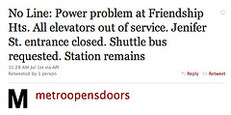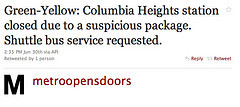Metro tweets welcome, could be even more useful
In recent years, Metro has made great strides into bettering communication with riders through new media. But there’s still room for improvement.
One of Metro’s newest communication tools is its use of Twitter. Service disruptions are regularly tweeted, giving riders on desktop computers or mobile devices an easy way to stay up to date.
Tweets are limited to 140 characters, but Metro’s initial attempts to use the platform resulted in many messages being cut short. After Unsuck DC Metro made fun of this with a few “complete the tweet” contests, Metro made some changes to their communications system. As a result, most tweets are no longer cut off. But many are still unclear.
Part of the problem lies in the API Metro uses to interface with their internet communications. Through it, Metro inputs basic service disruption data, and it generates information for their website and Twitter feeds. When disruptions are removed by staff from the system, it reports that to patrons as well. But that information is even more basic. Normally, it is just something along the lines of “Blue-Yellow: Disruption cleared.”
But the situation in the rail system is not always that clear. For instance, sometimes a rail line has more than one disruption. For example, a sick customer at Cheverly, and a police situation at Ballston. When the situation at Cheverly is resolved, Metro tweets that the Orange disruption has been cleared. But in reality, only one disruption has been cleared. Which one?
Another problem arises when only one station is involved. For instance, do you know which line Friendship Heights is on? It’s Red, but not as far as the Twitter notification system is concerned, which would report a problem in that station as “no line.”
In general, if a disruption does not affect what a train does at the station, it’s considered a “no line” disruption. But that is gobbledygook to riders, since they associate a problem affecting their station with at least one of the rail lines.
In order to improve this system, Metro could take several steps:
Remove extraneous data
Many of Metro’s tweets waste valuable characters by using full station names. Understandable abbreviations for stations and problems should be used. Instead of saying “Blue-Orange,” Metro’s tweets could save some letters by using “BL/OR.” “Twnbrk” is just as easily understood as “Twinbrook.”
And meaningless tweets like “Disruption cleared” should be avoided. Instead, those kinds of tweets should give helpful data to customers. “BL/OR: Police sit’n @ Ballstn resolvd. Delays continue to Vienna” is much better than “Blue-Orange: Disruption cleared.”
Clarify confusing data
Station closings are fairly frequent due to things like power problems or bomb scares. Metro’s tweets and email announcements rarely make it clear whether trains are passing through stations but not stopping or whether they are turning back on either side of the affected station.
Whenever a single station is involved, Metro communications should not only assign a line color, but also include data on whether trains are still passing through. This would be enormously helpful for riders. So a tweet might say: “GR/YL: Columbia Hgts sta. closed due to police sit’n. Trains passing through w/o stopping. Shuttles from U St, Georgia Av.
Keep it short
Metro should work on their API in an effort to keep tweets short and clear. One way this could be done is to allocate a certain number of characters to each aspect of tweets using a formula.
Every part of the disruption should be covered: Line(s), From Station, To Station, Reason, and Effect to Patrons. By assigning characters to each part, Metro’s API won’t be as likely to go over the 140 character limit.
Fixing these issues would help Metro continue to improve their communications with riders. Luckily, they seem to be trending in the right direction already.



